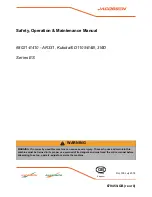
Battery
CALIFORNIA PROPOSITION 65 WARNING
:
Battery posts, terminals, and related accessories
contain lead and lead compounds, chemicals known
to the State of California to cause cancer and
reproductive harm. Wash hands after handling.
CAUTION:
If removing the battery, disconnect the
NEGATIVE (Black) wire from it’s terminal first,
followed by the POSITIVE (Red) wire. When re-
installing the battery, always connect the POSITIVE
(Red) wire its terminal first, followed by the
NEGATIVE (Black) wire.
Jump Starting
WARNING!
Never jump start a damaged or frozen
battery. Be certain the vehicles do not touch, and
ignitions are off. Do not allow cable clamps to touch.
Connect positive (
+
) cable to positive post (
+
) of your
tractor’s discharged battery.
Connect the other end of the cable to the (positive
+
) post
of the jumper battery.
Connect the second cable (negative
–
) to the other post of
the jumper battery.
Make the final connection on the engine block of the
tractor, away from the battery. Attach to a unpainted part
to assure a good connection.
CAUTION:
If the jumper battery is installed on a
vehicle (i.e. car, truck), do NOT start the vehicle’s
engine when jump starting your tractor.
Start the tractor (as instructed in the Operation section of
this manual).
Set the tractor’s parking brake before removing the jumper
cables, in reverse order of connection.
Charging
WARNING!
Batteries give off an explosive gas
while charging. Charge the battery in a well
ventilated area and keep away from an open flame
or pilot light as on a water heater, space heater,
furnace, clothes dryer or other gas appliances.
CAUTION:
When charging your tractor’s battery,
use only a charger designed for 12V lead-acid
batteries. Read your battery charger’s Owner’s
Manual prior to charging your tractor’s battery.
Always follow its instructions and heed its warnings.
If your tractor has not been put into use for an extended period
of time, charge the battery as follows:
Set your battery charger to deliver a max of 10 amperes.
If your battery charger is automatic, charge the battery until the
charger indicates that charging is complete. If the charger is not
automatic, charge for no fewer than eight hours.
1.
2.
3.
4.
5.
6.
1.
Fuse
WARNING!
Before servicing, repairing, or
inspecting, always disengage PTO, set parking
brake, stop engine and remove key to prevent
unintended starting.
A 20 Amp fuse is installed in your tractor’s wiring harness to
protect the tractor’s electrical system from damage caused by
excessive amperage.
If the electrical system does not function, or your tractor’s engine
will not crank, first check to be certain that the fuse has not
blown. It is located under the hood, mounted behind the top of
the dash panel on the support bar.
CAUTION:
Always use a replacement fuse with the
same amperage capacity as the blown fuse.
Tires
WARNING!
Never exceed the maximum inflation
pressure shown on the sidewall of the tire.
The recommended operating tire pressure is approximately 10
psi for the rear tires and 14 psi for the front tires. Refer to the
tire sidewall for exact tire manufacturer’s recommended or
maximum psi. Do not overinflate.
Uneven tire pressure could cause the cutting deck to mow
unevenly.
Changing the Transmission Drive Belt
Several components must be removed and special tools used in
order to change the tractor’s transmission drive belt. See your
Cub Cadet dealer to have the transmission drive belt replaced
s
ectiOn
7 — s
ervice
Summary of Contents for GT1554
Page 29: ...Figure 7 7 29 Section 7 Service...
Page 34: ...Notes 11 34...
Page 65: ...Figura 7 7 29 Secci n 7 Servicio...
Page 70: ...Notas 11 34...
















































